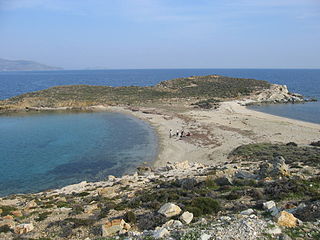A spit or sandspit is a deposition bar or beach landform found off coasts. It develops in places where re-entrance occurs, such as at cove's headlands, by the process of longshore drift and longshore currents. The drift occurs due to waves meeting the beach at an oblique angle, moving sediment down the beach in a zigzag pattern. This is complemented by longshore currents, which further transport sediment through the water alongside the beach. These currents are caused by the same waves that cause the drift.
Hydrology and geology

Where the direction of the shore inland re-enters, or changes direction, such as at a headland, the longshore current spreads out or dissipates. No longer able to carry the full load, much of the sediment is dropped, called deposition. This submerged bar of sediment allows longshore drift or littoral drift, to continue to transport in the direction the waves are breaking, forming an above-water spit. Without the complementary process of littoral drift, the bar would not build above the surface of the waves becoming a spit and would instead be leveled off underwater.
Spits occur when longshore drift reaches a section of headland where the turn is greater than 30 degrees. They will continue out into the sea until water pressure (such as from a river) becomes too much to allow the sand to deposit. The spit may then be grown upon and become stable and often fertile. A spit may be considered a specialized form of a shoal. As spits grow, the water behind them is sheltered from wind and waves, and a salt marsh is likely to develop.
Wave refraction can occur at the end of a spit, carrying sediment around the end to form a hook or recurved spit. Wave refraction in multiple directions will cause a complex spit to form. Incoming waves that come in a direction other than obliquely along the spit will halt the growth of the spit, shorten it or eventually destroy it entirely.
The sediments that make up spits come from a variety of sources including rivers and eroding bluffs, and changes there can have a large impact on spits and other coastal landforms. Activities such as logging and farming upstream can increase the sediment load of rivers, which may hurt the intertidal environments around spits by smothering delicate habitat. Roads or bulkheads built along bluffs can drastically reduce the volume of sediment eroded, so that not enough material is being pushed along to maintain a given spit.
If the supply of sediment is interrupted the sand at the neck (landward side) of the spit may be moved towards the head, eventually creating an island. If the supply isn't interrupted, and the spit isn't breached by the sea (or, if across an estuary, the river) the spit may become a bar, with both ends joined to land, and form a lagoon behind the bar. If an island lies offshore near where the coast changes direction, and the spit continues to grow until it connects the island to the mainland, it is then called a tombolo.
The end of a spit attached to land is called the proximal end, and the end jutting out into water is called the distal end.
Spits around the world
The longest spit in the world is the Arabat Spit in the Sea of Azov. It is approximately 110Â km (68Â mi) long.
Farewell Spit in New Zealand, at 32Â km (20Â mi), in the north-west corner of South Island is believed to be caused by the strong prevailing winds and currents, bringing sand eroded from the Southern Alps of the South Island and depositing these into Golden Bay.
Spits in the UK are caused by prevailing southwesterly winds, which give the spits their direction. However, when the direction of the wind changes for a short while, the spit may change in direction for a short while, forming a hook. Many spits have hooked or curved ends. One spit in the UK can be found in Dorset. Chesil Beach is a 29Â km (18Â mi) long shingle that connects Weymouth to the Isle of Portland. Chesil Beach provides shelter to Weymouth and the Portland village of Chiswell from prevailing winds and waves. You can also find Spurn Point in Yorkshire and the Humber it is approximately 4.8Â km (3.0Â mi).
The Curonian Spit off the coast of Lithuania and Kaliningrad Oblast of Russia separates the Curonian Lagoon from the Baltic Sea and is 98 km (61 mi) long. In a similar fashion, the Vistula Spit separates the Vistula Lagoon from the Gdańsk Bay off the coast of Poland.
Human settlement patterns

Since prehistory humans have chosen certain spit formations as sites for human habitation. In some cases such as Chumash Native American prehistorical settlement, these sites have been chosen for proximity to marine resource exploitation; for example, the Chumash settlement on the Morro Bay sandspit is one such location.
See also
- List of spits
- Shoal, a related landform
- Ria, often confused with spit







0 komentar :
Posting Komentar